Hubert
Pilgrimage Church of St. John of Nepomuk
Pilgrimage Church of St. John of Nepomuk (Inscribed)
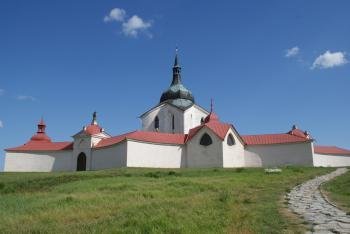
The Pilgrimage Church of St. John of Nepomuk is located on the top of a green hill (Zelena Hora) near the town of Zdar nad Sazavou. The complex consists of the central church with a ground plan in the form of a 5-pointed star and the surrounding cloister in the form of a 10-pointed star. It is no wonder that most of the photos that can be found in the Web show the church from the bird's eye view. But not only the geometry of the ground plan is unusual. Also the architectural style with the combination of Gothic and Baroque elements is exceptional. As mentioned by other reviewers, the symbolism of the number '5' plays a major role and it is fun to look for the '5' everywhere inside and outside.
The church itself is rather small and it does not take long time to visit the interior. There is little decoration and ornament in the church, but because of the five-sided geometry there is only little shadow, the interior is bright, and the sun generated nice light effects through the stained glass windows.
All in all, this WHS can be visited in less than an hour. That we've spent a fair bit more time there was mainly due to the beautiful weather. The bright blue sky in combination with the white of the walls, the red of the roofs, and the green grass around gave the whole scenery a very special charm. Such circumstances often contribute significantly to …
Keep reading 0 comments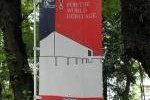
On my way to the National Museum in Tokyo, I had a quick look at the National Museum of Western Art, which is also located in Ueno Park. I was surprised to see banners displaying "**** for the world heritage!". The **** was in Japanese only, but must be 'National Museum of Western Art', as an image of that building is depicted on the banner also.
So the Japanese are still hoping that a Le Corbusier nomination will be accepted at the third attempt. At the last deferral in 2011, ICOMOS strongly advised cutting down the serial nomination from 19 to 3. These final 3 all are located in France. But it left a glimmer of hope also for the Museum in Tokyo, as it "is said to have been hugely inspirational in terms of impact on Japanese post-war architectural development".
The museum was still closed when I walked by in the early morning. I only shot some photos from behind gates, in the pouring rain. Its exterior I did not find very remarkable. This is the third of the Corbusier long list that I saw, after the Casa Curutchet in Argentina and the (very fine) Villa Jeanneret in Switzerland. I quite like the idea of the global spread of the works of one architect, so I hope something will come of it eventually.
Keep reading 0 comments
My family and I visited the ruins in the early 70s there was nothing there at all ....just the ruins and they were all overgrown and mystical a beautiful untouched place to be.... I will never forget the experience... and would like to remember it as it was...a truly exceptional place of beauty...and tranquility.......................
Keep reading 0 comments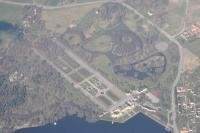
Located outside Stockholm on the Island of Lovön, the Versailles of Sweden, Drottningholm Palace was my first Swedish and Scandinavian World Heritage Site I visited in the year 2001, it was a fondly memory that I had a chance to unexpectedly greet by HM the Queen of Sweden while my mother and I joined the palace tour. Revisited in 2012 I took the same old way by using the T-Bana to Brommaplan then bus to the palace. The first view of Drottningholm by the lakeside was beautiful as always. My friend and I entered the palace, after saw many royal palaces in recent years, my views on Drottningholm changed badly. The first time I visited here I was pleased to see the interior, but for second time I hardly enjoyed or excited and even bored!
The best thing of Drottningholm was its garden behind the palace; I really liked the size of the garden as it was not too big and the distance from the palace to Chinese Pavilion was lovely for leisurely strolling. The Guard Tent was another highlight; this white-blue copper tent in the garden was full of details and quite unique to Swedish Palaces; however this tent was not the best in my opinion, the one in Haga Park in Northern Stockholm was much better. The Chinese Pavilion in the far end of the garden was quite nice but nothing looked Chinese at all! Nevertheless the curved line of its copper roof, and some furniture inside the …
Keep reading 0 comments
Like all other reviewers so far, I did not get into the core zone of Shirakami. I am looking forward to hearing from anyone who did – even a trip report to the Anmon waterfalls would be fine. It's located in the original buffer zone and presented that way on local maps. The WHC notes of 1993 seem to suggest that Japan put the buffer and core zone into one core area.
To get a feel for the site, I combined a half circle around it on the JR Gono Line with a stop at Juniko.
My train journey started in Hirosaki, just to the north of the Shirakami mountains. From this city, one has the best view of the highest mountain peaks, which even in June are still covered with a lot of snow. I had a reservation on the “Resort Shirakami”, a special train that runs a few times a day during the season. It is quite comfy and has extra large windows so you can enjoy the views. They are not so great however when you want to take photos – there’s a lot of reflection. How I miss the Indian trains, that travel with their doors open and sometimes even don’t have glass in the windows!
For the first hour, we traveled slowly from village to village, still in the civilised world. There’s a live music performance on board with traditional Japanese string instruments. Fortunately, this ends after 15 minutes. After that, the …
Keep reading 0 comments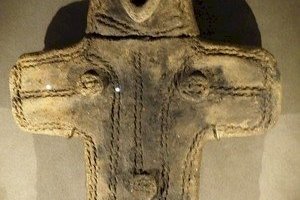
I don't know what the rank of the 'Jomon sites' is among the current Japanese tentative sites. There's not really one site that jumps out from their current Tentative List, maybe one or two of the early industrial sites could be a good angle for Japan to choose. According to this report, the Tomioka Silk Mill indeed will be next (in 2014).
But you never know, so while travelling between the WHS of Hiraizumi and Shirakami-Sanchi I stopped by at one of the Jomon sites. These are a cluster of 15 prehistoric archeological sites at the northern tip of Tohoku province and the south of Hokkaido. I choose Sannai-Maruyama in Aomori city, both for its accessibility and because it seems to be the most developed location.
Directions by public transport were a bit sketchy, so I took a taxi from Aomori station to bring me some 7km to the outskirts of the city. In a true example of Japanese ways, the taxi driver with whom I had no language in common decided that I should make the best of my visit to Sannai-Maruyama and called ahead with his mobile to announce that an English speaking visitor was to arrive. He then went inside the main building with me to secure that I was given a volunteer guide that spoke English. The girls behind the desk were all very excited having a guest from 'Oranda' anyway.
So I went on to visit the site with the (at …
Keep reading 0 comments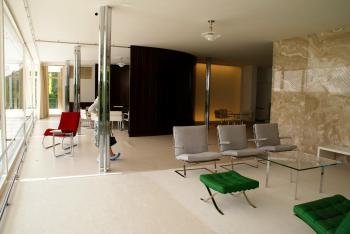
As a fan of modern architecture, I could hardly wait until after years of restoration the Tugendhat Villa has been re-opened to the public. It must be said that they have really done a great job. Architects, preservationists and historians have studied old plans, archives and historical photographs and were able to renovate the villa to its original state. The massive damage that resulted from decades of disinterest, some strange uses (e.g. by a dance school or a children's hospital) and previous, inappropriate restorations were eliminated. Some parts of the original interior could be retrieved, others were (or will be) replaced by faithful replica. The greatest success was that the makassar-ebony wall of the dining room, which was missed since the Second World War, has been recovered. Towards the street, the villa appears like a simple bungalow with garage. And also the lobby and the upper floor show nothing exceptional: white walls, a little chrome, the usual furniture of bedrooms and children's rooms. But after climbing down the elegant staircase, you have a real wow-effect: A large, light-flooded room, supported by thin, chromium-plated columns and separated only by an onyx wall, elements of exotic wood or fine curtains. And the elegant furniture, also designed by Mies, some specifically for the villa. The room has a large, continuous window front on two sides providing a vast panorama of the city of Brno. Mies van der Rohe has built the villa cleverly into a steeply sloping property, the white-painted villa is a …
Keep reading 0 comments
The Lednice-Valtice cultural landscape is a large, man-made landscape designed by the Liechtenstein family according to the principles of the English landscape architecture. To call it just a park would be an understatement. The main sites are the two castles in Lednice and Valtice, about 10 km apart, but the core zone also includes about 15 small buildings: small castles, temple, colonnades, a minaret, etc. Some of them are open to the public.
We arrived at Lednice on a Monday morning, thus the question if we should take a guided tour to the castle didn't arise (like almost everywhere in Europe guided tours are not available on Mondays). Furthermore, it was a sunny, warm day, so we decided to rent bikes (in Lednice) and to explore the landscape. We cycled the whole day through forests and around ponds and we visited almost all of the small buildings in the area, only Pohanska and Lany were too far away. We have enjoyed our bike tour very much. The routes between the buildings are partially bumpy dirt roads, thus the best is to rent a mountain bike. The terrain is flat almost everywhere, only the route to the Colonnades south-west of Valtice goes uphill through the vineyards. But the effort is worthwhile, it is one of the most beautiful buildings of the WHS. We also liked the Minaret, the Three Graces and the Apollo Temple. Most of the buildings are in good condition, it seems that there have been some restorations since …
Keep reading 0 comments
Müstair is a small village in the Romansh-speaking part of Switzerland, just 1 km from the Italian border. The main (well, only) attraction is the impressive Convent of St. John, which consists of a small church and the main building, which is still an active monastery with a handful of nuns. The church itself can be visited free of charge. Only the convent itself, which includes a reasonably interesting exhibition, charges for admission. The medieval frescoes are very big and really beautiful, and certainly merit its inclusion on the WH list, since there are very few remains from this period, and even fewer in such a good condition. The historic value and scenic setting in a beautiful mountain landscape make this a worthwhile trip, even though Müstair is a bit out of the way. It can actually be quite easily reached by public transport from Zernez in Switzerland (passing through the scenic Swiss National Park) and from Mals in Italy (and from there over the Reschen Pass to Austria).
Keep reading 0 comments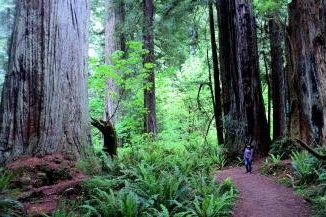
Following the previous days 11 hour drive from Los Angeles, visiting Redwood National Park is a challenge because of its remote location. (5 hrs drive north from San Francisco) Nevertheless, having the privledge and opportunity to visit such an ancient coastal Redwood forest was without a doubt a worthwile experience.
What sets Redwood National Park aside from other California National Parks that have old-growth forests is the diversity of landscape. For those wanting to stroll around ancient trees, visit the Lady Bird Johnson Grove. During the morning fog, this grove is something you will never forget. There are numerous other groves throughout the park, but to provide the full picture of this incredible ecosystem visit other areas as well. I would recommend hiking Fern Canyon Trail, a fairly short hike that follows a small stream amidst vertical vine/fern covered canyon walls. Furthermore, there are over 50 km of coastline in the park. Enjoy a perfectly empty California beach in the summer! This is another unique aspect of Redwoods National Park, it recieves a fraction of the visitors compared to Yosemite or Yellowstone. Large areas of prairie are also found in the park, and it is not uncommon to spot a herd of Elk grazing. Redwood National and State Parks is one of the United States best national parks and a worthy world heritage site.
Keep reading 0 comments
On my first ever visit to Twyfelfontein i was amazed with all the various rock formation and the arid desert surviving mopane trees.
I thought for a time this is one of the best scene perfect for movie making.
Have you ever imagine how the ancesters would dwell round in those boulders, man busy with rock art women with beads and children enjoying the perfect hot spring.
Taking your imagination futher what about the Jurassic age how green would have been there.
I was astonist to get all abovemention ideas running through my mind.
When i realize that the art left behind is for us to interprete and enjoy.Well there is all kinds of interpretation to the art as the academic ,scholars ,locas, visitors who so ever can just came and express what they see and leave every thing as it is for the next generations to enjoy.
Well for the youth as the future leaders let us try to penetrate the science of archaelogy.
Keep reading 0 comments
The Cologne Cathedral has a special place in my family. My late father, Guenter Schmitz, was one of the resident sculptors in the early and mid 1950's responsible for restoration work after the war. The most prominent of his work is the masonry of the big window between the two spires above the entrance. We emigrated to South Africa in 1967. Even if my father was not involved with the Cathedral, I am very glad to see that it has been declared as world heritage site.
Keep reading 0 comments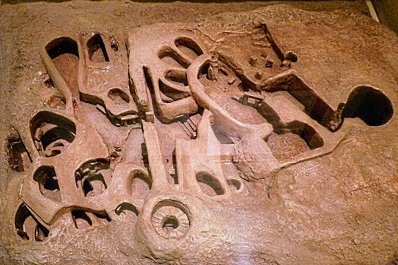
Hal Saflieni is an archaeological site of world significance whose “visit experience”, put in place as part of a major conservation project lasting some 10 years which ended in 2000, is worthy of it. If you are visiting Malta you should book ahead to ensure that you are one of those very few people allowed in each day!
The site consists of a series of underground burial chambers cut into the living rock through 3 levels to a depth of some 11m below street level in the suburb of Paola which is 20 minutes by bus from the Valletta terminal. You enter through what looks like just another terraced house in a side street to find that you are in a visitor centre built over the entire excavated site after 4 such houses had been demolished. The low key street frontage has been maintained, giving no impression of what lies within and below.
Each hourly tour allows a maximum of 10 visitors (and our experience was that even this is perhaps 2 too many!!). Look on the Heritage Malta Web site for up to date details and to book. Most of our group had booked as early as January for a tour in late April. A notice on the door indicated that the next 2 day’s tours were full – and, as I look again on May 2, the entire month is “full”! However, elsewhere there was reference to a procedure by which the first and last tours …
Keep reading 0 comments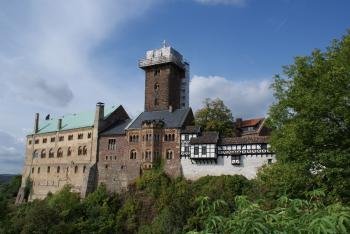
In general, castles and palaces are not my favourite kind of WHS. But Wartburg Castle is an exception. I was there twice: on a foggy winter day in 1990, shortly after the fall of the Berlin Wall, and in the summer of 2009. Both times the atmosphere was different, but whatever the weather the location on a narrow, steep ridge is stunning. And obviously King Ludwig II of Bavaria was also impressed by the Wartburg. There he got a lot of inspiration for his Neuschwanstein Castle.
The Wartburg Castle was never destroyed by war and thus it is a mixture of different architectural styles: Romanesque, Gothic, Renaissance and Historicism. The entrance gate and the half-timbered buildings of the outer bailey are from the 14th and 15th Century, the middle parts are from the mid-19th Century, and the main castle, the Palas, is in the Romanesque style. The entrance to the courtyards is free, but despite the queues a tour of the interior is worthwhile.
The Wartburg was significant for many periods of German history, and references can be seen inside the Palas. Noteworthy is the simply designed Romanesque knight's hall with its cross vault. In 1206, the Wartburg was the scene of the Minnesingers' contest. Although this is a legend, it has a historical background. At that time, the Wartburg was a famous centre for European arts and culture. The Thuringian landgrave Hermann I invited well-known poets and singers to stay at the Wartburg. However, the design of the Singers' …
Keep reading 0 comments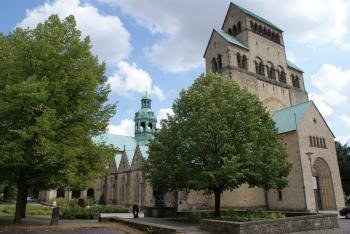
As I visited Hildesheim in September 2009, the Cathedral of St. Mary's was still open (now closed for renovation until 2014) and at St. Michael the renovation of the interior was already completed, only one outer wall was partly under scaffolding. Both churches are the best examples of early-Romanesque architecture and interior design. The typical elements are visible: thick, fortress-like walls, massive towers, and the typical round arches. In particular St. Michael beautifully illustrates the geometric principles of Romanesque style. In the Second World War both churches were almost completely destroyed and rebuilt in the 1950s. The Baroque ornaments were omitted, and the churches were rebuilt in their presumed original Romanesque style.
A significant part of the WHS is the art treasure from the 11th century: the two-winged bronze door (with depictions of the history of salvation), the Christ column (depicting scenes of Jesus' life), the Hezilo-Candelabrium. As other reviewers, I was impressed by the colourful wooden ceiling in St. Michael. Its effect is even enhanced by the sparse decoration of the interior.
I like to visit medieval cathedrals and monasteries, I like the mood and the atmosphere there. But there are a lot of them on the WH list and sometimes it is hard to understand why a certain cathedral is a World Heritage site and another one is not. The special features in Hildesheim are the pure Romanesque style and the extraordinary art treasures. A visit is worthwhile if you are in the area. The city is easily …
Keep reading 0 comments
I visited Volklingen Ironworks in May 2010 and spent at least 2 hours wandering and climbing over the entire works. It was an amazing experience. I had spent 8 years of my younger like working as a welder in the Bethlehem Steel Sparrows Point shipyard, immediately adjacent to the huge Beth Steel furnaces and mills, across a small inlet from the (odoriferous) coke ovens (where we'd steal coke for our warming fire pots during the winter). Knowing what it was to work at Sparrows Point, and then visualizing what it would appear as a quiet(!) ghost town sent shivers down my spine. I only wish I knew German to be able to read the workers' graffiti!! (I know what I left as graffiti at Sparrows Point). I will go back again and take even more time to walk and climb it.
Keep reading 0 comments
I arrived at Yakushima’s Miyanoura Port from Kagoshima by jetfoil. There are several boats a day by various companies, which is indicative of the popularity this island has among Japanese holidaymakers. People do come here mostly for hiking, and in the main street of Miyanoura well-outfitted Japanese hikers is a common sight. The town itself has a few thousand inhabitants, several good restaurants, a large supermarket and places to stay. And plenty of souvenir shops, of course, selling mostly wooden items.
Hiking is what I did on my first full day too. I went to Shiratani, located a mere half hour uphill by bus. This is the starting point for several short and longer walks. The drive up there already was enough to win me over for this island. The scenery really is spectacular – trees, trees and more trees, in every shade of green that exists. I was on a “normal” local bus, but the bus driver halted at a viewpoint anyway to let me and 6 fellow passengers take photos of the landscape. And he did so too when we encountered a group of Japanese macaques by the side of the road. Many “oohs” and “aahs” were uttered at the sight of these monkeys just next to our bus. It even got better when they were joined by a Sika deer. So we had seen the two most prominent mammal species of the island before even getting into the national park.
At Shiratani, I opted to …
Keep reading 0 comments
Putorana Pleateau: In June of 2001 I was a tourist with the MIR Corporation and 6 of us tourists along with a MIR guide and a guide from Novosibirsk joined an 8 member crew on a small boat, the Zarya, to deliver food and oil packages to villages along the Yenesei River with the Russian/American endeavor called "Project-Aid Siberia." In Turukhansk we met a doctor who invited us to join him and his friends for a fishing trip along the tributaries of the lower Tunguska River. Of course, transportation was by helicopter. On the way home that evening, our pilot set our helicopter down on the edge of the Putorana Plateau and we made our
way over the rocks and tundra to the edge. The view was spectacular and it was an experience I will never forget.
Keep reading 0 comments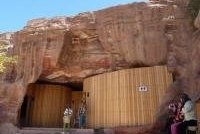
Petra holds a special place in my “travel memory” as, back in 1964, I visited it on my first major “expedition” whilst hitch-hiking from UK to Jerusalem (then in Jordan) and back. Since then I have revisited it 1999 and in 2012. Enormous changes have taken place to the “visit experience” over those years. Many of them are irreversible but that doesn’t mean that they are welcome – the concern now is what the coming years will bring and whether Petra itself can survive and provide a worthwhile visit?
In 1964 there was no entrance fee, I just signed in at the police check-point and slept overnight in one of the caves. There were almost no other visitors (though it was low season August) and, on my departure evening, I slept on the floor outside Wadi Musa police station as there wasn’t suitable lodging in what was then a tiny village – happy days! Of course there were no “Lonely Planet” guide books or similar and, although an on-site Archaeologist was helpful, I really saw the site “blind” and, inevitably, missed much of its significance. Visitor information boards had not yet reached the site!
By 1999 the place was transformed, with a busy (and rather untidy) town having grown up just beyond the entrance – and a 5* hotel. Entry fees had reached JD20. Our latest visit in 2012 identified even more people and more changes. Entry fees had risen beyond inflation – Jordan now gets JD50 per person and …
Keep reading 0 comments
I visited Vigan just two weeks ago. My memory and impressions are overall indeed tilted to the positive side. I found it hard to articulate succinctly. Let me just give one point.
In terms of showing information relevant to the visitor clearly, Vigan probably does a marvellous task in one stroke, not often found in Asian towns of Vigan's size. The map produced by the city government is very understandable, helpful, nice looking, convenient. You don't even have to get a paper copy. At the intersection of Crisologo and Liberation there is a very clear map on a wall. Always get back to this intersection and you will find your way in Vigan.
Keep reading 0 comments